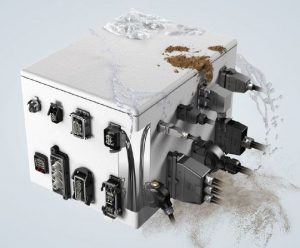 Connectivity trends according to HARTING: Choices in form factor
Connectivity trends according to HARTING: Choices in form factor
August 21, 2019 REDWIRE is news you can use from leading suppliers. Powered by FRASERS.
Posted by Harting Canada Inc
The family-owned HARTING Group is a global leader in connectivity solutions. HARTING invented the modular connector and... Read more
Subscribe
Free REDWIRE e-newsletter

The shape of the connector plays a massive role in its usability, says HARTING.
In this five-part article, HARTING Canada explores the five main trends in industrial connectivity today. This second part discusses the variations between rectangular and circular connectors.
All connectors are made up of a mated pair (commonly referred to as the plug and receptacle). Each half is equipped with pin (male) and socket (female) contacts. Contacts are made of a conductive metal. The contacts are housed in a dielectric insulator (typically called an insert). The insert with contacts is then housed in a protective enclosure (hood and housing) that protects the electrical components and inserts from environmental damage and corrosion.
All industrial connectors have these features and can be generally categorized into two basic shapes: rectangular and circular. The shape of the connector plays a massive role in its usability.
History of circular and rectangular connectors
Circular connectors were initially developed in the 1930s and were adopted by the U.S. Department of Defense for use in the extremely harsh aeronautical- and tactical-service applications. These connectors, along with their evolutionary derivatives, are commonly called “Military Standard”, “Mil-STD”, “MIL-SPEC”, or “MS” connectors.
Today, they are used in a wide variety of industrial applications beyond the military. A traditional circular connector is mated by threading on the plug and receptacle that hold the connector in place. Rectangular industrial connectors were invented by Wilhelm Harting in 1956 as a direct response to circular MIL-SPEC connectors.
Rectangular connectors offer the same reliability in an extremely harsh environment. They can be installed close together and are typically locked with levers (although internal locking mechanisms are possible).
Small pin count favours circular, while rectangular works better for large pin counts
The number of pins plays a big role in the size of the connector. When the pin count in a specific connection point is low (three to five), a circular connector tends to be smaller. As the pin count grows, so does the radius of the connector, making it larger in all directions.
In contrast, a low pin count rectangular connector tends to be larger than a circular one with the same pin count. However, once more than five pins are needed, a rectangular connector is smaller because the shape can be expanded in one direction.
If panel density is important, rectangular connectors tend to win
Panel density refers to how close connection points need to be to one another. If an application requires many connections in a small area, connectors that offer high panel density are required. Determining how many connectors can fit in a specific area means looking at two things: the size of the connector and the space needed around the connector for locking.
While a circular connector may be smaller, typically additional space is required for a hand to twist it into space. Rectangular connectors with double latches can be placed next to one another on the panel making more connections in a specific place possible.
Circular is ideal for single-use low-power connection points, while rectangular connectors are perfect for high-power or multi-use connection
For some applications, each connection point needs to be separate. This could be because the connection points perform a single low-power function and are connected to different periphery devices. In this case, an M8, M12 or M23 circular connector does the job.
When higher power is needed or if an engineer wants to combine power, signal or data in one connection point, rectangular wins out. Modular rectangular connectors enable the combination of power, signal and data into one connector using off-the-shelf modules.
Hybrid circular connectors do exist, but they tend to be custom products with long lead times.
Specific environments demand specific shapes
Connector shape can play an unexpected role when considering the environment that the connector will be in. One of the clearest examples is in wash-down environments in the food and beverage industry.
It is common knowledge that machines in food and beverage processing must have components that are suitable for wash-down with high-pressure hoses (IP69K rating). However, it must be impossible for food to get stuck in crevices. Angles are a no-no in connectors for food and beverage, so a circular connector is required.
The future of connectivity: the right shape for the right application
Finding the right connector for an application does not have to be a challenge. If you are starting a project or need help finding a connector, HARTING’s technical support team is here to help.
HARTING’s portfolio of rectangular and circular connectors means whatever the application, there is a solution from the world leader in industrial connectivity.
To learn more, contact HARTING.
Share
Posted by Harting Canada Inc
The family-owned HARTING Group is a global leader in connectivity solutions. HARTING invented the modular connector and... Read more